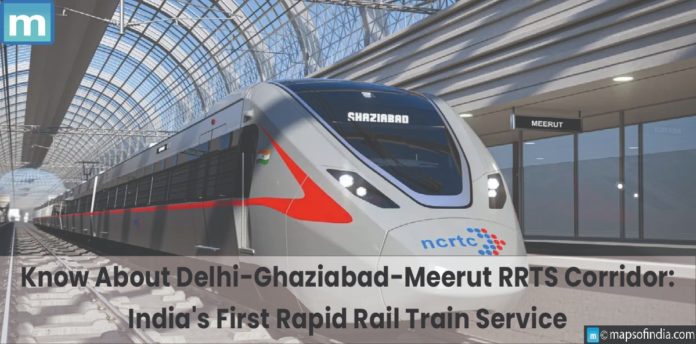Prime Minister Narendra Modi launched the 17-kilometer priority portion of the Delhi-Ghaziabad-Meerut Regional Rapid Transit System (RRTS) on October 20, 2023. The priority section of the 82.15-kilometer line between Sahibabad and Duhai Depot was inaugurated and passengers can use the service from October 21, 2023. Five stations will be in the priority section: Sahibabad, Ghaziabad, Guldhar, Duhai, and Duhai Depot. However, that’s just half part of the project.
What is the Delhi-Meerut RRTS?
The Delhi-Meerut Regional Rapid Transit System, popularly known as RapidX, is India’s first regional rapid transit system currently being built. It is a semi-high-speed rail corridor connecting the National Capital Region (NCR) cities of Delhi, Ghaziabad, and Meerut. The corridor will be 82.15 kilometers long, with 22 stations and two depots in Duhai and Modipuram. The National Capital Region Transport Corporation (NCRTC), a joint venture between the Government of India and the NCR state governments, is developing the Delhi-Meerut RRTS. The project is expected to be completed by 2025 and will cost ₹30274 crore (US$3.8 billion).
All 22 Stations
Sarai Kale Khan, New Ashok Nagar, Anand Vihar, Sahibabad, Ghaziabad, Guldhar, Duhai, Murad Nagar, Modi Nagar South, Modi Nagar North, Meerut South, Partapur, Ritani, Shatabdi Nagar, Brahmapuri, Meerut Central, Bhaisali, Begum Pul, MES Colony, Daurli, Meerut North, and Modipuram are the stations on the Delhi-Meerut RRTS route.
Ticket Fare
The passengers will pay between Rs 20 and Rs 50 for Standard Class from Sahibabad to Duhai Depot, according to the fare rates announced by NCRTC. Additionally, there is one premium class, with a range of Rs. 40 to Rs. 100.
Key Features
-
Speed
The RRTS trains will have a maximum speed of 180 km/h, reducing the travel time between Delhi and Meerut to less than 60 minutes.
-
Frequency
The RRTS trains will operate at a frequency of 15 minutes during peak hours, providing commuters with a fast and reliable mode of transportation.
-
Capacity
Each RRTS train will have a capacity of 1,200 passengers, which will help to reduce congestion on the roads and highways.
-
Safety
The RRTS will have the latest safety features, such as automatic train control (ATC) and collision avoidance system (CAS).
-
Comfort
The RRTS trains will have comfortable seats, air conditioning, and other amenities to ensure a pleasant journey for commuters, including free Wi-Fi.
Multi-modal integration
The Delhi-Meerut RRTS stations would be linked to other modes of transportation, including the Delhi Metro, buses, and taxis. Commuters could easily transition between modes of transportation and complete their journey.
Corridors Under Development
The project will create eight corridors, three of which are now under construction: the 82-kilometer Delhi-Ghaziabad-Meerut, the 164-kilometer Delhi-Gurugram-SNB-Alwar, and the 103-kilometer Delhi-Panipat corridors. Future routes include Delhi-Faridabad-Ballabgarh-Palwal; Ghaziabad-Khurja; Delhi-Bahadurgarh-Rohtak; Ghaziabad-Hapur; and Delhi-Shahadra-Baraut.
Benefits
-
Reduced travel time
The Delhi-Meerut RRTS will significantly reduce the travel time between Delhi and Meerut. This will make it a more viable commuting option for people living in both cities and make it easier to travel between the cities for other purposes, such as business and leisure.
-
Reduced traffic congestion
The Delhi-Meerut RRTS is expected to reduce traffic congestion between Delhi and Meerut. This will improve air quality and make the roads safer for everyone.
-
Economic development
The Delhi-Meerut RRTS is expected to boost economic development in the region. It will provide better connectivity and make it easier for businesses to attract and retain employees.





